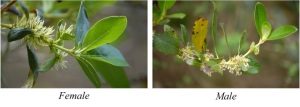Updated: 31/03/2025
Variation in size between sexes is something that we associate mainly with animals. But what about plants? Do female plants have larger elves than males? Find out in the Early View paper in Oikos “Sexual size dimorphism in island plants: the niche variation hypothesis and insular size changes” by Patrick H. Kavanagh and Kevin C. Burns. below is their summary of the study:
Sexual size dimorphism (SSD) is common throughout the animal kingdom. Size differences between the sexes are often extreme and in many cases one sex may be twice the size of the other. While most plants are hermaphroditic, approximately 7% of flowering plants are dioecious (separate male and female individuals). SSD is also common in dioecious plants, yet has received far less attention than SSD in animals. The niche variation hypothesis predicts the degree of SSD to increase for insular populations as a response to increased intraspecific competition. Many animal taxa conform to this prediction, however SSD of island plant populations had not been investigated.
We investigated differences in SSD between related island and mainland plants by using herbarium material. Specifically, we quantified the sizes of leaves and stems for plants from the New Zealand mainland and surrounding offshore islands. Our results suggest that the degree of SSD is not predictable for island plants, contrary to predictions of the niche variation hypothesis. Furthermore, SSD was consistently female biased on the mainland, however the direction of SSD was not predictable on islands. Our results suggest that both sexes are under selection for increased size on islands. This may contribute to SSD being unpredictable due to the sexes responding to selection at different rates. However, further work is needed to gain a better understanding of SSD in island plant populations.

